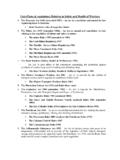Transcription of Environmental Policy and Regulation in RUSSIA - OECD.org
1 Environmental Policy and Regulation in RUSSIA THE IMPLEMENTATION CHALLENGE OECD ORGANISATION FOR ECONOMIC CO-OPERATION AND DEVELOPMENT The OECD is a unique forum where the governments of 30 democracies work together to address the economic, social, and Environmental challenges of globalisation. The OECD is also at the forefront of efforts to understand and to help governments respond to new developments and concerns, such as corporate governance, the information economy, and the challenges of an ageing population. The Organisation provides a setting where governments can compare Policy experiences, seek answers to common problems, identify good practice, and work to co-ordinate domestic and international policies. The OECD Member countries are: Australia, Austria, Belgium, Canada, the Czech Republic, Denmark, Finland, France, Germany, Greece, Hungary, Iceland, Ireland, Italy, Japan, Korea, Lu x em bou rg, Mex ico, the N etherland s, New Zealand, Norway, Poland, Portugal, the Slovak Republic, Spain, Sweden, Switzerland, Turkey, the United Kingdom, and the United States.
2 The Commission of the European Communities takes part in the work of the OECD. OECD Publishing disseminates widely the results of the statistics gathered by the Organisation and its research on economic, social, and Environmental issues, as well as the conventions, guidelines, and standards agreed by its Members. The opinions expressed and arguments employed herein do not necessarily reflect the official views of the Organisation or of the governments of its Member countries. OECD (2006) No reproduction, copy, transmission, or translation of this publication may be made without written permission. Applications should be sent to OECD Publishing: or by fax (+33-1) 45 24 13 91. Permission to photocopy a portion of this work should be addressed to the Centre Fran ais d exploitation du droit de Copie, 20 rue des Grands-Augustins, 75006 Paris, France FOREWORD The OECD s cooperation with RUSSIA in the field of environment started in the mid 1990s and aims to assist RUSSIA in integrating Environmental considerations into the economic reform process and to promote dialogue between OECD member countries and RUSSIA on Environmental Policy issues of mutual interest.
3 The development of the Environmental Performance Review of RUSSIA , carried out by the OECD Secretariat in cooperation with UNECE in 1999, constituted a milestone of cooperation. The Review was the first comprehensive and independent assessment of Environmental conditions and policies in RUSSIA . Subsequently, analyses of specific instruments of Environmental Policy , most importantly pollution and natural resource charges, were conducted. The current report continues this series of Policy analyses and provides an update of the developments in Environmental policies and Regulation , as well as government strategies for ensuring compliance with regulatory requirements in RUSSIA since 2000. The study was mainly prepared on the basis of literature review by the OECD Secretariat with a substantial support from Ms.
4 Olga Dubovik, Professor at the Russian Institute for Governance and Law. Valuable input into the development of the study were provided by officials from the Russian Federal Service for Environmental , Industrial and Nuclear Supervision (Rostekhnadzor), namely Ms. Victoria Sapozhnikova, Mr. Andrei Pechkurov, Mr. Evghenii Wystrobets and Mr. Yurii Planonov. Factual information and expert opinions were also collected during several workshops and interviews with stakeholders. Most importantly, an International Conference Strategies for Improving Environmental Compliance Assurance in RUSSIA : Policy and Practical Issues was organised on 19-20 October 2005 in Moscow by the OECD Secretariat and Rostekhnadzor. The objective of this event was to discuss latest developments of Environmental management in RUSSIA and take stock of opportunities and obstacles to improving this system within the framework of the administrative reform and in light of good international practice.
5 The views expressed in this report are those of authors and do not necessarily reflect those of the Russian authorities, the OECD or its member countries. 4 TABLE OF CONTENTS CHAPTER 1: OBJECTIVES AND INSTRUMENTS OF Environmental 7 Evolution of Environmental management in RUSSIA .. 7 Environmental Policy objectives and obstacles to their 7 Major changes in the institutional framework .. 10 Core instruments of Environmental Policy .. 13 Information basis for Policy -making .. 22 CHAPTER 2: RECENT CHANGES IN THE LEGAL 24 Structure and focus of Environmental 24 Law-making 25 Constitutional provision and primary legislation .. 26 Selected sectoral legislation .. 30 Secondary 31 Legislation developed at the sub-national 32 Plans for law-making at the federal level.
6 32 CHAPTER 3: GOVERNMENT STRATEGIES FOR ENSURING Environmental 33 Responsibilities and powers of Environmental enforcement authorities .. 33 Activity 36 Compliance assistance .. 39 Self-control and self-reporting by enterprises .. 39 Government capacity to conduct laboratory control of emissions .. 40 On-site visits .. 41 Public information and participation .. 42 Compliance levels and non-compliance 43 Performance 47 KEY FINDINGS AND 49 5 EXECUTIVE SUMMARY Establishing a modern Environmental management system that would match new economic and social realities was one of the challenges that RUSSIA faced during the transition period. In order to address this challenge, important efforts were dedicated to the development of legal and institutional frameworks.
7 Environmental laws and regulations now address most of the priority Environmental issues. Government agencies responsible for Environmental Policy design, Regulation , and compliance act at both federal and sub-national levels, and Environmental Policy implementation is increasingly decentralised. During the last five years, innovative Policy instruments (such as industry rating, Environmental management systems and corporate reporting) have been adopted or further promoted, and traditional instruments ( Environmental quality standards, permitting, and Environmental liability) have been under reform. However, Environmental policies and regulations continue to suffer from an important implementation gap.
8 A rapid expansion of the regulatory framework resulted in a general loss of coherence. Although the government is taking action to improve the quality of regulations , many unfeasible or unenforceable rules are still in force. Economic instruments remained ineffective in changing Environmental behaviour. The compliance assurance strategies continued to rely on the check and punish approach. While regulatory requirements are contradictory or sometimes unrealistic, the emphasis placed on compliance with rules hinders the acceptance of Regulation and lowers credibility of the government. Furthermore, Environmental authorities have been subject to multiple reorganisations and ever-increasing fragmentation since the late 1990s that sometimes brought them to the edge of institutional paralysis.
9 There is a need for further reform of Environmental policies, laws, institutions, and compliance assurance strategies in the Russian Federation. Priority should be given to the following actions: i) Overcome the declarative character and fragmentation of Environmental Policy making and reform Policy instruments. In procedural terms, authorities need to increase the transparency, stakeholder involvement, and accountability of the Policy -making process; ii) Pursue the better Regulation process in the environment field with a view of making laws and regulations realistic, more performance-based, enforceable, coherent, and simple. To this end, an effective use of the Regulatory Impact Analysis should be ensured; iii) Design a modern Environmental compliance assurance system based on a better knowledge of the regulatees profile, particularly factors that prevent Environmental compliance.
10 In conjunction with a higher transparency and accountability of Environmental authorities, the legal framework should be amended to allow for an unimpeded access to facilities, when necessary, including a risk-based frequency of inspection and unannounced on-site visits; iv) Fully implement the key principles of Environmental federalism and strengthen the institutional framework for Environmental management ; v) Encourage meaningful public participation and empower stakeholders to act as partners of governmental authorities. The current report supports these conclusions and recommendations with background information that covers developments in the Russian system of Environmental management since the late 1990s. 6 ACRONYMS BAT Best Available Technique CFD Compensation for Damages EIA Environmental Impact Assessment ELV Emission (Effluent) Limit Value EMS Environmental management System EQS Environmental Quality Standard EU European Union IPPC Integrated Pollution Prevention and Control MAC Maximum Allowable Concentration MEA Multilateral Environmental Agreement NGO Non-governmental Organization OECD Organisation for Economic Cooperation and Development RIA Regulatory Impact Analysis SME Small and Medium-sized Enterprises 7 CHAPTER 1.















